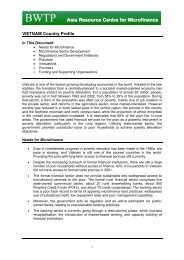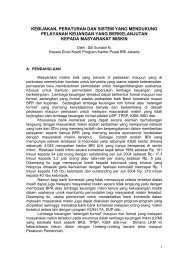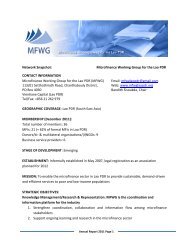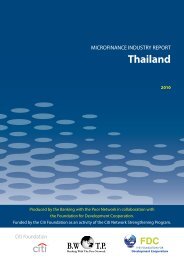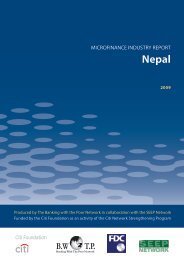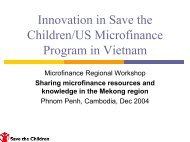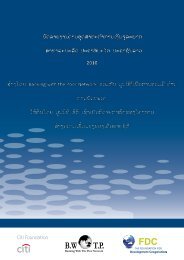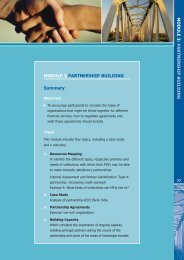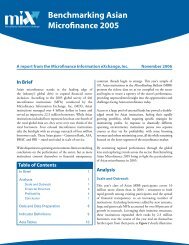Microfinance Industry Report: Indonesia - Banking with the Poor ...
Microfinance Industry Report: Indonesia - Banking with the Poor ...
Microfinance Industry Report: Indonesia - Banking with the Poor ...
You also want an ePaper? Increase the reach of your titles
YUMPU automatically turns print PDFs into web optimized ePapers that Google loves.
6. Financial Regulation, for <strong>Microfinance</strong><br />
6.1 Bank regulation<br />
The legislation governing <strong>the</strong> banking system in<br />
<strong>Indonesia</strong> (<strong>the</strong> <strong>Banking</strong> Act, 1992 and amending<br />
legislation of 1998) provides for two kinds of banks.<br />
There are general commercial banks (Bank Umum)<br />
offering a full range of financial products. They have<br />
access to <strong>the</strong> payment system and provide general<br />
banking services, and foreign exchange services.<br />
They require a paid-up capital of Rp.10 billion (USD<br />
1 million).The second category of bank is <strong>the</strong> Bank<br />
Perkreditan Rakyat (BPR). Initially set up <strong>with</strong> paidup<br />
capital of 50 million rupiah, this requirement<br />
was increased in 1999 to RP 500 million rupiah<br />
(USD 50,000) for local areas. Minimum capital<br />
requirements were also increased for BPRs operating<br />
in <strong>the</strong> Jakarta region, from Rp.50 million to Rp.2<br />
billion (US$200,000), and for provincial capitals to<br />
Rp.1 billion (US$100,000).<br />
In 2003, <strong>with</strong> <strong>the</strong> amendment of <strong>the</strong> Bank <strong>Indonesia</strong><br />
Act, <strong>the</strong> transfer of banking supervision from Bank<br />
<strong>Indonesia</strong> was mandated. A Financial Services<br />
Supervisory Agency (LPJK) now performs this function<br />
while Bank <strong>Indonesia</strong> retains responsibility for<br />
monetary policy and banking system development.<br />
BI also retains certain residual functions having to do<br />
<strong>with</strong> micro-, small- and medium enterprise financing<br />
(but not for refinancing such lending). These are<br />
discussed fur<strong>the</strong>r below. In addition, <strong>the</strong> LPJK has<br />
special arrangements <strong>with</strong> o<strong>the</strong>r institutions to<br />
supervise on its behalf, such as BKDs supervised<br />
by Bank BRI branches. For supervising commercial<br />
banks, LPJK uses a CAMEL (Capital, Assets quality,<br />
Management, Earnings, Liquidity) rating system<br />
comprising seven ratios and 25 questions. For<br />
BPRs <strong>the</strong> six components of <strong>the</strong> CAMEL rating are<br />
employed in a simplified format. After <strong>the</strong> financial<br />
crisis of 1997-98, a drastic process of rationalization<br />
occurred in <strong>the</strong> commercial banking system, as<br />
described above. A parallel process occurred among<br />
<strong>the</strong> BPRs, whose numbers fell by some 400 to a total<br />
of 1,800 during 2008<br />
6.2 Regulation of non-bank financial<br />
institutions<br />
Lembaga Dana Kredit Pedesaan (LDKP), or ‘Rural<br />
Fund and Credit Institutions’, set up by provincial<br />
governments, have been encouraged to convert<br />
into BPRs but (as mentioned above) a majority have<br />
not done so. Therefore LDKPs are still licensed and<br />
regulated by provincial governments, while technical<br />
assistance and supervision is usually delegated to<br />
regional development banks (BPDs), also owned by<br />
provincial governments. While LDKPs are restricted<br />
in mobilising savings, a specific category of LDKP in<br />
Bali, <strong>the</strong> Lembaga Perkreditan Desa (LPD) or ‘village<br />
credit board’ is allowed by Bank <strong>Indonesia</strong> to accept<br />
deposits from members at village level, <strong>with</strong> <strong>the</strong><br />
requirement that <strong>the</strong>y do not describe <strong>the</strong>mselves as<br />
banks. Semi-formal institutions such as LDKPs, LPDs,<br />
microfinance cooperatives, credit unions, and NGOs<br />
are outside <strong>the</strong> legal framework of banks, and have<br />
an unclear legal status in <strong>the</strong> financial system. This<br />
might represent a risk for small depositors in cases<br />
where such institutions accept deposits.<br />
6.3 Cooperative regulation<br />
Although a legal framework for cooperatives exists<br />
in <strong>Indonesia</strong>, <strong>the</strong>ir active supervision is hindered<br />
by <strong>the</strong> lack of capacity of <strong>the</strong> responsible central<br />
agency, <strong>the</strong> Ministry of Cooperatives and Small<br />
and Medium Enterprises. The cooperative sector is<br />
regulated by a government regulation of 1995 and<br />
a ministerial decree of 1998, which restricts credit<br />
and savings activities to financial cooperatives (KSP)<br />
or specialised units of multipurpose cooperatives<br />
(USP). Minimum capital requirements are also<br />
imposed.<br />
6.4 The law on foundations<br />
In 2001, following a series of abuses of <strong>the</strong> non-profit<br />
organisation status, <strong>the</strong> government passed <strong>the</strong> first<br />
ever law on foundations (<strong>the</strong> common form of NGOs<br />
in <strong>Indonesia</strong>). According to <strong>the</strong> law, foundations<br />
may only provide social, humanitarian and religious<br />
services and are prevented from being involved in<br />
income-generating or economic activities such<br />
as microfinance. Existing foundations were given<br />
20 microfinance industry report - INDONESIA<br />
<strong>Indonesia</strong>_<strong>Report</strong>_forprint.indd 20<br />
27/05/2009 3:14:43 PM



